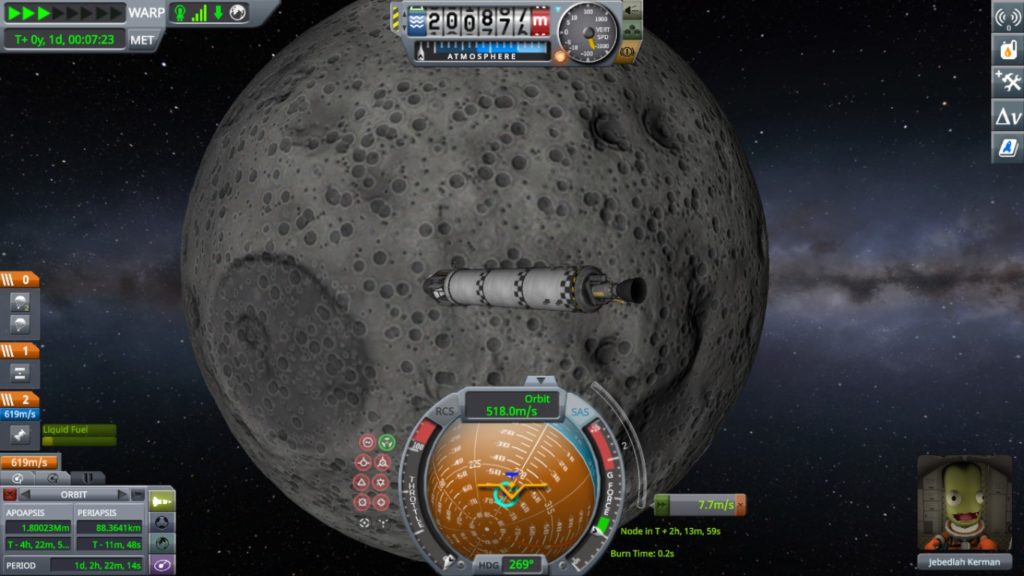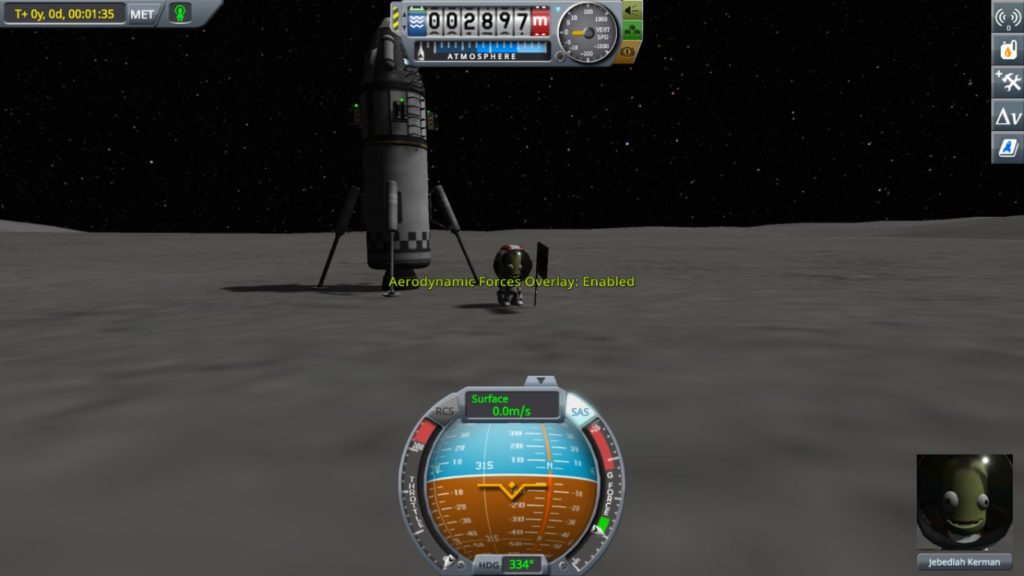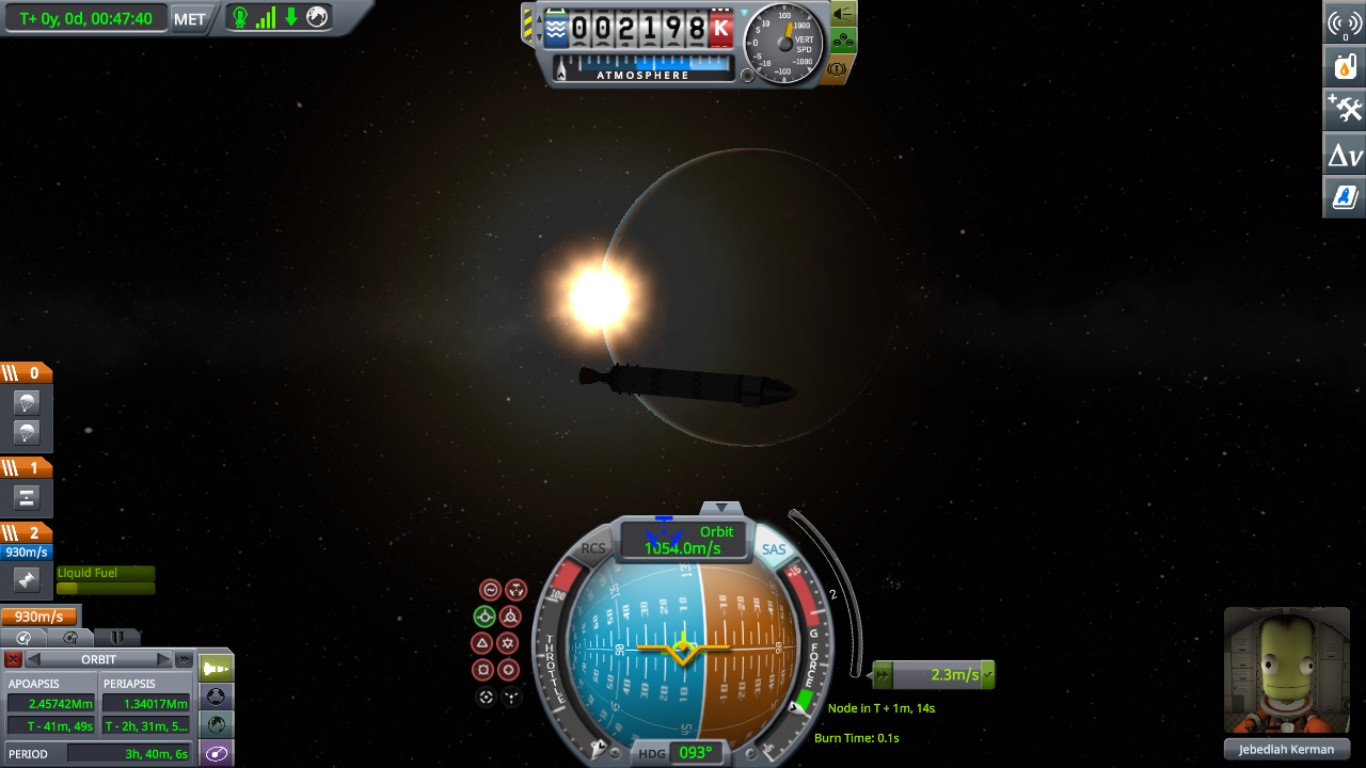I am reasonably confident that at one point or another, every child went through a phase where they wanted to be an astronaut. The idea of strapping into a massive rocketship and blasting off to explore the vast, uncharted grandeur of space definitely speaks to the pioneer nature in all of us, and if you’re of a certain age, you might have grown up with fascinating stories of the space race with movies like The Right Stuff or Apollo 13 reinforcing this notion. Unfortunately, as we got older, we realized that there were a few pesky obstacles in our path to Cape Canaveral like “extremely high physical fitness requirements” and “deep proficiency in science and mathematics”. Still, the itch to go out into the great vast unknown might not have left all of us, and for those folks, they get the chance to indulge with today’s piece of the Big Steaming Pile, 2015’s Kerbal Space Program by Squad and Private Division.
Kerbal Space Program, as the title implies, puts you in charge of a space program comprised entirely of a rather frog-like race called Kerbals, that reside on the planet Kerbin, part of the Kerbol solar system. Your objective, such as it is, is to slap together some rockets and see what’s out there, all while (ideally) trying to make sure your little green buddies make it back home in one piece. There are three game modes here: Sandbox, where all the different parts and materials are available right from the jump, Science, where you have to unlock new components by earning Science points gained through conducting experiments during flights, and Career, which takes the Science requirements and adds features like your program’s reputation, your budget, and allowing you to take contracts to perform certain goals.
Now, despite the rather whimsical nature of the Kerbals themselves, this is a pretty heavy-duty simulation of actual space exploration. That said, even if you’re not the most STEM-inclined person out there (which I very much am not), there are a series of helpful tutorials to help you figure out what you’re trying to accomplish and why you will need to take the steps you will, so even if you’re not a Ph.D in physics, the game does an outstanding job breaking down concepts like delta-v, apoasis and periasis, and transorbital injections into rather bite-sized nuggets for laypeople. And if you need something explained lickety-split, there’s another fantastic resource in the form of the KSPedia, which can be accessed even in mid-flight, just in case you need a quick refresher on what the difference between normal and anti-normal maneuvers are.

As you might imagine, which game mode you choose to play through is going to wildly alter how you go about your business. Playing on Sandbox Mode, you’ll probably be inclined to go nuts and start building the biggest, bossest rockets and spaceplanes you can imagine, taking the approach that by God, you WILL get to the planet Duna because you damn sure put enough boosters on there that it shouldn’t be a problem. Playing on Career or even the less restrictive Science Mode, you’re gonna have to come to grips very quickly with the idea of stretching every drop of fuel and skimming off every excess pound in your payload. No matter which way you choose to play, however, you still feel very much free to experiment with whatever designs you want and cobble together some of the wackiest flying machines imaginable. Even if you come up with something that in no way, shape, or form is going to be able to break the surly bonds of Kerbin, the game doesn’t stop you until you bring it out to the launchpad and get slapped across the face by the cold, emotionless hand of physical laws.
Oddly enough, though, the failure is part of the fun here, as it makes it just that much more rewarding when you do work the kinks out and put something up into orbit or get to that next spot out there, and it does become useful over time to reflect back on previous mistakes and what you learn from them, like maybe that it’s not a great idea to make a spacecraft top-heavy or that just attaching ALL THE BOOSTERS you can doesn’t exactly make for the safest of vessels. I can also attest that this very wide-open approach is extremely engaging, as I would occasionally randomly think about my designs even when I wasn’t playing and would brainstorm improvements or new ideas that I wanted to test out whenever I got back to it.
For a concept as theoretically complex as space exploration, the actual gameplay mechanisms themselves are fairly simple. Building a spacecraft is a streamlined process where most everything snaps into place and the different categories of parts are divvied up in a way that feels easy to digest. Most components have some important statistics about them, such as a gimbaled engine telling you what its range of motion is, which allows you to change direction more easily, or what the impact tolerance of a certain part is. Different designs you create can be saved for easy recall and tweaking, and you can name your creations and type in a description for each one, so anyone looking to go visit the planet Jool on-board the Scootiepuff Sr. is more than welcome to. When it comes to actually piloting your spacecraft, that too is a relatively simple process. Orbital manuevers can be planned well ahead of time and assisted by a sort of autopilot that can automatically orient you towards the direction you need to be facing, and you’re capable of speeding time up along the way, which is very useful unless you’re a serious purist and want to wait for actual hours to go from one planet’s orbital range to anothere. Also, unless you’re flying a spaceplane, your reaction times and actual piloting ability are almost never called into serious action, so even those that tend to shy away from regular flight sims have nothing to fear here.
Kerbal Space Program is also a rather pleasant looking and sounding experience. Aside from the very cartoony nature of the Kerbals, the graphics are quite believable and enjoyable, from the bursts of flame shooting from a solid fuel booster to the beauty of the various celestial bodies to the very visible heat searing off your craft at re-entry. The sound, especially the background music as you putt around through space is quite relaxing and inviting as well, which contrasts well with the immense void you’re shooting through.

I should point out, though, that there are two things in particular that might cause you to not want to go scoop this one up. Number one, for a game that’s almost five years old now, it can be rather buggy at times. The worst of these bugs, colloquially referred to as The Kraken, is a weird distortion of physics that generally happens when you’re first loading up a flight, and manifests itself in the form of an unexplainable wobble. This wobble can cause massive problems at launch, as if your rockets are tilting in different directions at takeoff, you are…not gonna be in for a good time. This problem can be exacerbated on other planets, as well, where the combination of the wobble and lower gravity can tip your spacecraft over entirely or knock over structures you’ve built on the surface. For me, I found that the World Stabilizer mod was an essential download to avert this problem, but it can still crop up in a more minor fashion. Number two, there is a sequel in the works, so it might not be the best idea to run out and grab this if it turns out that the second iteration is gonna be hot on its heels.
Ultimately, though, Kerbal Space Program is an extremely enjoyable space sim that perfectly manages to balance realism and accessability. It can be a tremendous time sink, whether you’re landing on new planets or going back to the drawing board after a spectacular disaster. It’s also the best kind of sneaky educational, where you don’t realize how much you’re secretly learning about physics in general and orbital dynamics until you’re putting them into practice like second nature. If you are at all interested in space travel or are just a big ol’ science nerd, I would heartily recommend this one. Just remember, Mun or Bust also means Mun (and back) or Bust.
Current Price – $39.99
Is It Worth It? – Unquestionably if you have any interest at all in spaceflight and exploration.
